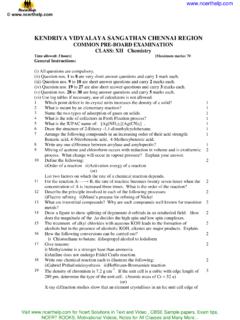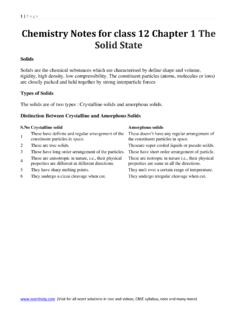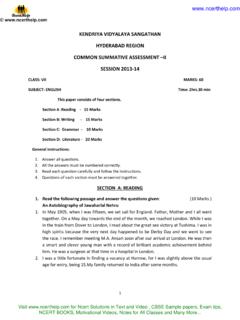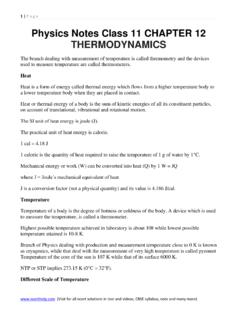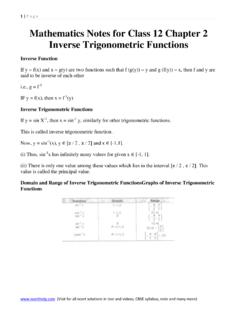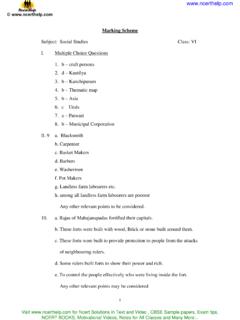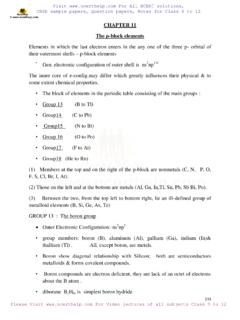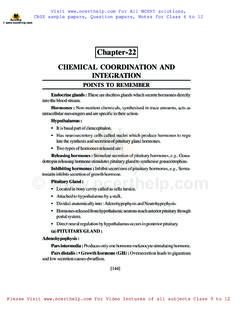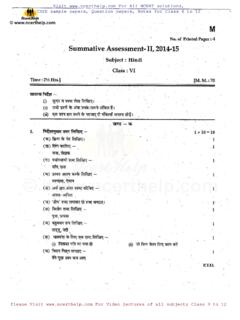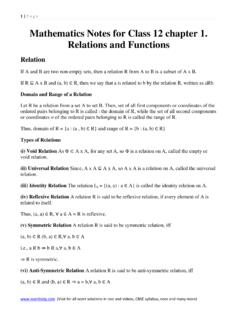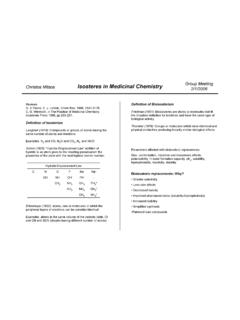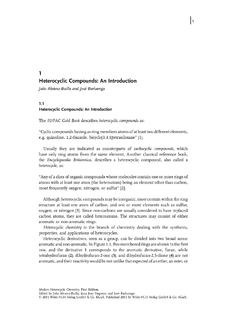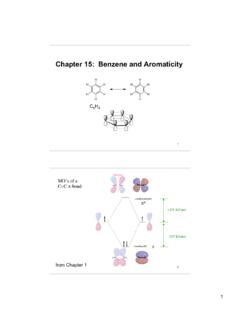Transcription of Chemistry Notes for class 12 Chapter 14 Biomolecules
1 1|Page Chemistry Notes for class 12 Chapter 14. Biomolecules Biomolecules are the organic compounds which form the basis of life, , they build up the living system and responsible for their growth and maintenance. The sequence that relates Biomolecules to living organism is Biomolecules Organelles Cells Tissues Organs Living organism. Carbohydrates Optically active polyhydroxy aldehydes (aldcses) or ketones (ketoses) or compounds which on hydrolysis give these units are known as carbohydrates. They are also called saccharides (Latin Saccharum = sugar) due to sweet taste of simpler members. Depending upon their behaviour towards hydrolysis, carbohydrates can be of following three types Monosaccharides These cannot be hydrolysed to simpler molecules and further subdivided into tetroses, pentoses or hexoses depending upon the number of carbon atoms.
2 These are also called homopolysaccharides. Aldotetroses Erythrose, Threose Aldopentoses Xylose, Ribose, Aldohexoses Glucose, Galactose, Ketohexoses Fructose All naturally occurring monosaccharides belong to D-series. killiani synthesis is used to convert an aldose into next higher aldose. Oligosaccharides (Greek oligos = few). On hydrolysis, they generally give two to nine monosaccharides (same or different) and are further classified as disaccharides, , sucrose, maltose, lactose, trisaccharides and so on. C12H22O11 is a disaccharide because it gives two monosaccharides. (Visit for all ncert solutions in text and videos, CBSE syllabus, note and many more). 2|Page The bond formed between two monosaccharides is called a glycosidic bond and normally it is (1, 4) bond.
3 Sucrose is most abundant in plants and known as cane sugar or table sugar or invert sugar as equimolar mixture of glucose and fructose is obtained by hydrolysis of sucrose. Trisaccharides Raffinose (C18H32O16). Polysaccharides These are polymers of monosaccharides. Examples are starch, cellulose, glycogen, etc. 1. Starch, (C6H10O5)N. It is a polymer of a-glucose and a major reserve food in plants. It turns blue with iodine. It is a mixture of two components: 1. Amylose (20%), an unbranched water soluble polymer. 2. Amylopectin (80%), a branched water insoluble polymer. Sources of starch are potatoes, wheat, rice, maize, etc. (Visit for all ncert solutions in text and videos, CBSE syllabus, note and many more).
4 3|Page 2. Cellulose, (C6H10O5)n It is the most abundant and structural, polysaccharide of plants. It is important food source of some animals It is a polymer of D (+) -glucose. The chief sources of cellulose are wood (Contains 50% cellulose rest being lignin, resins, etc). and cotton (contains 90% cellulose rest being fats and waxes). (Visit for all ncert solutions in text and videos, CBSE syllabus, note and many more). 4|Page Several materials are obtained from cellulose: 1. Mercerised cotton Cellulose treated with cone. sodium hydroxide solution acquire silky lustre. It is called mercerissd cotton. 2. Gun cotton It is completely nitrated cellulose (cellulose nitrate), highly explosive in nature and is used in the manufacture of smokeless gun powder, called blasting gelatin.
5 3. Cellulose acetate It is used for making acetate rayon and motion picture films. 4. Cellulosexanthate It is obtained by treating cellulose with sodium hydroxide and carbon disulphide and is the basic material for VISCOSE rayon. Oligosaccharides and heteropolysaccharides are also called heteropolysaccharides. Reducing and Non-reducing sugars Based upon reducing and non-reducing properties, carbohydrates are classified as reducing and non-reducing sugars. Carbohydrates reducing Fehling reagent or Tollen s reagent are termed as reducing carbohydrates. , All monosaccharides and disaccharides (except sucrose). But carbohydrates which do not reduce such reagents are known as non-reducing carbohydrates.
6 , sucrose and polysaccharides. Sugars and Non-sugars On the basis of their, taste, carbohydrates are classified as sugars and non-sugars. The monosaccharides and oligosaccharides having sweet taste are collectively known as sugars. Polysaccharides which are insoluble in water and not sweet in taste, are non-sugars. Glucose Dextrose, grape sugar, corn sugar, blood sugar (C6H12O6). Manufacture By hydrolysis of starch with hot dil mineral acids and by hydrolysis of sucrose. (Visit for all ncert solutions in text and videos, CBSE syllabus, note and many more). 5|Page Extra glucose is stored in liver as glycogen. and glucose In intermolecular hemiacetal formation (cyclic structure), -CHO is converted into -CHOH.
7 Which can have two configurations as shown below. Glucose having (i) configuration about C1 is the -glucose and having (ii) configuration about C1 is -glucose. The carbon C1 is known as anomeric carbon and these compounds are called anomers. Both the forms are optically active. ex-D-glucosehas specific rotation + and -D-glucose has specific rotation + . Mutarotation When either of the two forms of glucose is dissolved in water, there is a spontaneous change in specific rotation till the equilibrium value of + . This is known as mutarotation. Properties of glucose Glucose has one aldehyde group, one primary hydroxyl (-CH2OH) and four secondary hydroxyl (-CHOH) groups and gives the following reactions: (Visit for all ncert solutions in text and videos, CBSE syllabus, note and many more).
8 6|Page These reactions confirm the presence ofa carbonyl group in glucose. (iii) Glucose reduces ammoniacal silver nitrate solution (Tollen s reagent) to metallic silver and also Fehling S solution or Benedict solution to reddish brown cuprous oxide (Cu 2O) and itself gets oxidised to gluconic acid. This confirms the presence of an aldehydic group in glucose. (iv) With mild oxidising agent like bromine water, glucose is oxidised to gluconic acid. Glucose on oxidation with nitric acid gives saccharic acid. (Visit for all ncert solutions in text and videos, CBSE syllabus, note and many more). 7|Page (vii) Glucose on reaction with methyl alcohol in the presence of dry HCl(g) forms and - methyl glycosides.
9 The reaction occurs only at the OH of hemiacetylic carbon. Cyclic structure of glucose Given by Haworth and Hirst. (Visit for all ncert solutions in text and videos, CBSE syllabus, note and many more). 8|Page Fructose Fruit Sugar (C6H12O6). Manufacture By hydrolysis of inulin. and -fructose The two forms have different configuration about C2. (Visit for all ncert solutions in text and videos, CBSE syllabus, note and many more). 9|Page Fructose does not reduce Br2 water. Epimers Monosaccharides differing in configuration at a carbon other than anomeric carbon are called epimers, , glucose and galactose differ in configuration at C4, hence called epimers. Osazones Monosaccharides and reducing disaccharides react with excess of phenyl hydrazine to form crystalline substances of the structure It is known as osazones glucose and fructose give same osazone.
10 Molisch Test for Carbohydrates In aqueous solution of compound add solution of -naphthol in alcohol and then cone. H2SO4 along the walls of the test tube. Purple coloured ring is obtained at the junction. (Visit for all ncert solutions in text and videos, CBSE syllabus, note and many more). 10 | P a g e Amino Acids The compounds containing amino group (-NH2) and carboxylic group (-COOH) are called amino acids. R = H, alkyl or aryl group. Except glycine ( ), others are optically active in nature. Classification of Amino Acids Essential and Non-essential Amino Acids Human body can synthesise ten amino acids, called non-essential amino acids. The remaining ten amino acids required for protein synthesis are not synthesised by body and are called essential amino acids.
